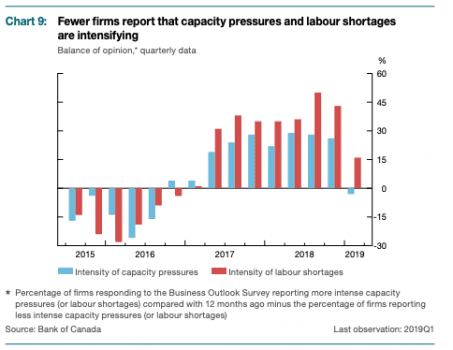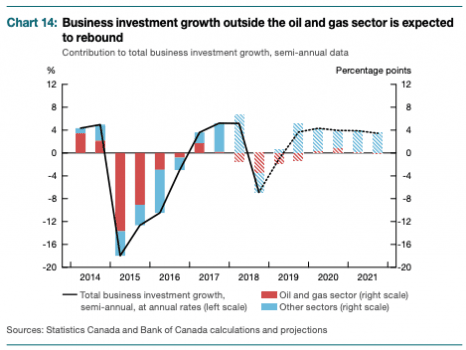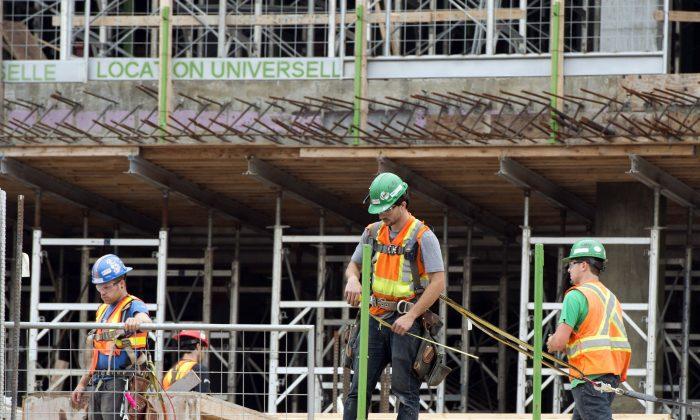NEWS ANALYSIS
As the Canadian economy remains stuck in quicksand, its labour market has become one of the few bright spots. But while job growth is robust, wage growth remains tepid due to the secular problems plaguing the economy, namely an uncompetitive business environment relative to the United States.He notes the Canadian economy has generated 404,500 jobs in the past year—the most since 2001.

The hiring is concentrated in Ontario and Quebec, which Cross suggests is due to firms playing catch-up after the election of business-friendly Conservative governments last year.
Other reasons are that productivity of 0.2 percent is very weak and far fewer firms are reporting labour shortages and capacity pressures, according to the Bank of Canada.
Labour at the Expense of Capital
To meet rising demand and to grow, firms can hire more workers and/or invest in equipment and technology. Facing any kind of uncertainty like from trade policy, Canadian firms are opting for hiring instead of investing. Hiring is a shorter-term solution with less longer-term obligations compared to making a long-term commitment like building a new factory.Firms in Canada—mainly outside the energy sector—have been dealing with tight labour markets for months. So there could also be a sense of not wanting to be understaffed that is driving the hiring, says Cross.

“In the short term, particularly after going through an experience of shortages, they’re hanging on to their workers and even increasing at the margins,” he said in an interview.
Canada’s weak exchange rate since the fall in oil prices in late-2014 also makes the price of capital expenditures more expensive. So labour again appears relatively cheaper. And given that wages have been stagnant, the cost of hiring workers is lower—the law of supply and demand at work.
But as business investment lags, productivity falls—and wages don’t rise. This is the trap Canada finds itself in while watching the U.S. economy grow at 3.2 percent in the first quarter, despite its government shutdown and traditionally bad weather. U.S. business investment has been growing at a solid clip.
The United States is showing Canada the “virtuous circle” of business investment and job and wage growth, says Cross. “There’s a very close correlation between business investment and labour—when both are growing they’re not substitutes, they grow hand in hand,” he said.
U.S. wage growth rose 3.2 percent in the last year. In Canada, wages grew 2.4 percent in aggregate. Excluding the weaker energy sector, wage growth for the more vibrant parts of the Canadian economy was just 2.6 percent in the fourth quarter. Economists expect the wage gap to widen between the two countries.
“We’ve ground to a halt and our number one trading partner is booming along,” Cross said.
Outlook
Cross says that with Jason Kenney at the helm in Alberta, it’s possible to see a rebound in employment. “Ontario and Quebec have demonstrated that politics are important to firms,” he said.The difference, Cross says, is that firms delayed hiring in Ontario and Quebec when the economy was reasonably strong, whereas in Alberta there isn’t that “catch-up factor” given the lengthy economic weakness.
“I think firms will be pleased with the change in government, but it may take a while before that shows up in hiring,” he said.
The dynamics behind rising wages in the short run appears to be closely tied to productivity and capital spending, but longer-term forces are also at work.
Aging working populations in the G7 has often been blamed for low wage gains. As highly paid baby boomers retire and younger, lower-paid workers enter the workforce, aggregate wage statistics are pulled lower.
“We may be seeing a lot of different relationships than we’re used to in macroeconomics,” Cross said.






Friends Read Free